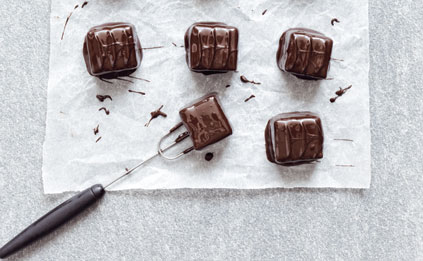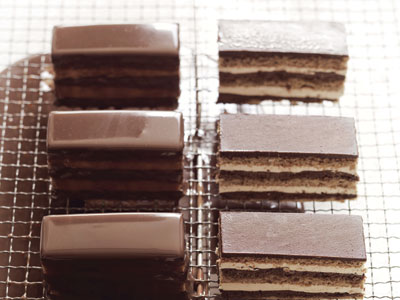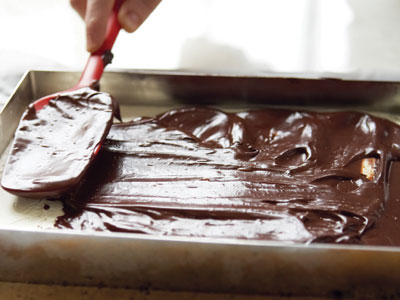Patisserie at Home, by Will Torrent
Award-winning pastry chef, Waitrose consultant and 2010 Acorn Scholarship winner Will Torrent published his first cookery book last month, Pâtisserie at Home. Here we share some extracts from his book, published by Ryland Peters & Small, with photography by Jonathan Gregson
GÂTEAU SAINT-HONORÉ
This is one of the most famous of all French pâtisseries, and it is definitely made to impress. The caramel-tipped pistachios are optional, but they add a touch of style. It is traditionally made as a large gâteau for the French patron saint of bakers and pastry chefs, Saint Honoré, but I make little individual ones as well.
250g store-bought puff pastry
1 egg yolk, to glaze
Summer berries, to decorate

Crème diplomate 250ml whipping cream
250ml double cream
500g store-bought crème pÁ¢tissière
2tbs Grand Marnier liqueur
Choux pastry
60ml water
70ml milk
50g butter
Pinch of salt
Pinch of sugar
70g plain flour
Approximately 6 eggs

Caramel 250g sugar
1tbs water
18cm round cake pan (optional)
2 baking sheets, lined with greaseproof paper
Piping bag, plain nozzle and star-shaped nozzle
Silicone mat (optional)
Using a rolling pin, roll out the puff pastry on a lightly floured surface until 6mm thick.
Lay the cake pan or an 18cm plate on the pastry and cut around it to make a disc. Transfer it to a prepared baking sheet. (Don't throw away the leftover trimmings of pastry - re-roll them, sprinkle grated cheese over them, stamp out rounds and bake to make little cheese puffs. They freeze raw too.)
For the choux pastry Preheat the oven to 200ËšC (400ËšF) Gas 6.
Put the water, milk, butter, salt and sugar in a medium saucepan over medium heat. Stir constantly with a silicone or wooden spoon so that the sugar doesn't burn and cause the mixture to stick to the bottom of the pan.
When it comes to the boil, quickly stir in the flour and mix together. Beat the dough vigorously until it cleanly leaves the sides of the saucepan - this can take up to 5 minutes, depending on the heat.
Transfer the dough to a stand mixer or mixing bowl (using an electric whisk) and beat in the eggs, one at a time. You might not need all 6 eggs - flour and eggs behave differently no matter how many times you make the same recipe, 
so the number of eggs needed 
can vary.
As you add the eggs and beat them in, watch the dough and, when it is soft and smooth and drops off a spoon leaving a 'V' shape, it is ready.
Fill a piping bag (fitted with a plain nozzle) with the choux pastry and pipe a ring around the edge of the pastry circle. Set the piping bag aside for a moment.
Brush egg yolk over the ring to give a lovely golden glaze.
Using the filled piping bag again, pipe about 7 bulbs onto another prepared baking sheet, about 5cm in diameter and spaced apart as they will expand during baking.
Put both baking sheets in the preheated oven and bake for 10 minutes. Lower the temperature to 180ËšC (350ËšF) Gas 4 and leave the oven door ajar ever so slightly to dry the buns out. They won't need that long but the base may need a further 20-25 minutes.
Remove from the oven and transfer the cake base and choux buns to a wire rack to cool.
For the caramel Put the sugar and water in a saucepan over low heat. Leave it to heat until the sugar has melted and don't be tempted to stir it. Continue cooking until it has turned to a golden caramel. Meanwhile, fill your sink with cold water. Once the caramel is ready, it will continue to cook even when it is taken off the heat and you don't want it to brown and burn, so dip the base of the pan into the sink of cold water for a few seconds, then set the pan safely on a towel.
Working quickly before the caramel sets, and being very careful not to touch the burning caramel with your fingers, dip the top of each choux bun into the caramel.
Set the buns, caramel side down, on a silicone mat or a sheet of greaseproof paper. This creates a neat, flat surface. Allow to cool completely.
For the crème diplomate Put the whipping cream and double cream in a stand mixer or use a mixing bowl and an electric whisk. Beat until soft, billowing peaks form.
Be careful not to over-whip it, otherwise it will become thick and grainy and will split when mixed in with the crème pÁ¢tissière.
Gently fold the whipped cream, in stages, into the crème pÁ¢tissière until smooth and irresistible. Fold in the Grand Marnier at the end.
Make a hole in the base of each cooled choux bun with a skewer. It needs to be just big enough to fit the tip of the piping nozzle. Fill a piping bag (fitted with a star-shaped nozzle) with two-thirds of the cream. Stick the tip of the nozzle in the hole in each cooled choux bun and fill (do not over-fill) with cream.
Now pipe shell shapes on top of the choux-pastry ring all the way around the cake. Arrange the filled choux buns on top, caramel side up.
Fill another piping bag (fitted with a plain nozzle) with the remaining cream and pipe bulbs in the middle of the cake.
Decorate with berries and impress your friends.
To make caramel pistachios for decoration, make a caramel as above using 100g sugar 
and 2 tablespoons of water.
Dip the base of the pan into 
the sink of cold water for a few seconds, then set the pan safely 
on a towel.
Stick a cocktail stick into one pistachio at a time and dip it into the caramel.
Pull it out of the caramel slowly to form a caramel trail.
Allow to set on a sheet of greaseproof paper before pulling the cocktail stick out.
PASSIONFRUIT, MANGO AND OLIVE OIL CHOCOLATES
I love to give traditional chocolates a twist by making them with fruit purées and olive oil. This particular tropical explosion tops a wonderfully crunchy sesame-seed base that has an extra little surprise when you bite into it - popping candy. It's fun and kids will love it.
I made a very similar version of this for a really good friend's wedding this year and seeing the guests' faces when they ate the chocolates was priceless. Grown men and women were reduced to childish laughter, reminiscing about years gone by and experiences with space dust.
INGREDIENTS

Start the recipe the day before you want to serve the chocolates.
(Makes about 25)
250g dark chocolate, tempered

Base
100g milk chocolate
100g tahini paste
50ml extra virgin olive oil
40g black sesame seeds
140g chocolate popping candy (available online)
Ganache
250ml mango and passionfruit smoothie
Juice of 2 passionfruit, strained
11â„2 tbs extra virgin olive oil
350g dark chocolate (Grenada origin, 66% cocoa, if you can 
find it), chopped
15cm square frame
For the base
Melt the milk chocolate and tahini paste in a heatproof bowl over a pan of simmering water (not letting the base of the bowl touch the water).
Allow to cool and thicken slightly, then add the olive oil, sesame seeds and popping candy.
Spread the mixture out on a sheet of greaseproof paper and 
top with another sheet. Roll it thinly with a rolling pin, then refrigerate 
to set, still between the sheets 
of paper.
Remove the chilled mixture from the fridge, remove the top sheet of paper and place the square frame over it. Press the frame down to cut all the way through the mixture, then leave the frame pressed 
in place.
For the ganache
Put the passionfruit and mango smoothie, passionfruit juice and olive oil in a saucepan and bring to the boil over low heat.
Pour the boiled mixture into a heatproof bowl and add the chocolate. Using a spatula, start to mix the ingredients in a circular motion, just in the centre of the bowl. Keep mixing in a tight circle until the chocolate starts to melt and emulsify with the liquid. Gradually widen the circle until all the chocolate has melted and you have a shiny, smooth ganache.
If the ganache looks like it is splitting, add a dash of cold milk - that should bring it back.
Pour the ganache into the frame over the crunchy base. Allow to set at room temperature overnight.
The next day, gently ease the frame away from the chocolate. Cut it into 5 rows of 5 squares each using a large, sharp knife.
Dip the chocolate squares in the melted chocolate with a dipping fork or regular fork and set on a sheet of greaseproof paper.
To create that professional pattern on top, lay the three prongs of the fork flat on top of each chocolate and when you lift the fork up again, drag it to the right. The melted chocolate will fall into that distinctive pattern. Allow to set.
OPÉRAS
The opéra, named after the Paris Grand Opéra of the 1900s, comprises neat layers of sponge, buttercream and ganache, all enticingly flavoured with coffee.
INGREDIENTS
Start the recipe the day before you want to serve the cake. Preheat the oven to 190˚C (375˚F) Gas 5.
(Makes 12)
8 tablespoons ready-made coffee

Almond cake
120g egg whites (about 4 egg whites)
80g caster sugar
4 eggs
130g ground almonds
75g icing sugar
40g plain flour
5tbs instant coffee granules
2tbs unsalted butter, melted and cooled

Ganache 300ml whipping cream
3 pinches of salt
500g dark chocolate (70% cocoa), chopped
100g milk chocolate, chopped
3tbs unsalted butter
2tsp instant coffee granules
Coffee Italian meringue buttercream 250g caster sugar
100ml water
5 large egg whites
50g caster sugar
500g unsalted butter, softened and cubed
1 shot of espresso or 50g instant coffee granules
3 Swiss roll pans, lined with greaseproof paper
Sugar thermometer
20 x 30cm rectangle frame
For the almond cake Put the egg whites and sugar in a stand mixer or in a bowl using an electric whisk and whisk until stiff peaks form.
Whisk in the whole eggs. Gently fold in the ground almonds, icing sugar, flour and coffee granules using a large metal spoon. Finally, stir in the melted butter.
Spread the mixture thinly and evenly onto the prepared pans and bake in the preheated oven for 5-10 minutes. Flip each slab of cake onto a sheet of greaseproof paper dusted with a little semolina. Peel the baking paper off the top and allow the cakes to cool.
For the ganache
Put the cream in a saucepan and bring to the boil over low heat. Put the chocolates, salt and butter in a heatproof bowl and pour in the boiled cream. Using a spatula, start to mix the ingredients in a circular motion, just in the centre of the bowl. Keep mixing in a tight circle until the chocolate starts to melt and emulsify with the liquid. Gradually widen the circle to incorporate more of the mixture.
When you have reached the edge of the bowl, the chocolate should be entirely melted and all the ingredients should have emulsified and combined into a shiny, rich, velvety truffle ganache. If the ganache looks like it is splitting, add a dash of cold milk - that should bring it back. Finally, fold in the coffee granules and allow to 
cool slightly.

For the coffee Italian meringue buttercream Put the 250g sugar and the water in a saucepan and bring to the boil. Simmer over low heat until the syrup reaches 121˚C/250˚F on a sugar thermometer. Use a brush dipped in cold water to dislodge any sugar crystals on the side of the pan. This will stop the syrup from crystallising.
Meanwhile, put the egg whites and the 50g sugar in a stand mixer and begin whisking until stiff peaks form. You can use a heatproof bowl and an electric whisk but you may need a second person's help when you come to pour the syrup in.
Once the syrup has reached the right temperature, slowly pour it in a steady stream into the meringue bowl with the beaters still running. Avoid letting the syrup touch the beaters, otherwise you'll get lumps of hardened sugar. Keep whisking until you have used up all the syrup and the meringue is glossy, thick and has cooled substantially - this may take several minutes of whisking. The bowl itself must have cooled too.
Now add the butter, a cube at a time, whisking well between each addition until the butter is used up and fully incorporated in the meringue. Finally, whisk in the coffee.
To assemble Press the rectangle frame on top of each cake slab in turn to cut out equal rectangles of cake. Leave the frame pressed into one cake and brush half the ready-made coffee over the cake within the frame. (below)
Spread half the meringue buttercream over that and spread level with a spatula.
Freeze for 10 minutes to set, then spoon one-quarter of the ganache over the top of the buttercream and spread level.
Place a second cake slab on top. Top with the remaining coffee, meringue buttercream and a quarter of the ganache as before and freeze for 30 minutes to set.
Place the last cake slab on the top and spread another quarter of the ganache over it. Freeze overnight, still in its frame, and reserve the last of the ganache.
The next day, warm the reserved ganache to liquify it. Gently ease the frame away from the layered opéra and cut it into 12 neat fingers using a hot, sharp knife.
Put the slices on a wire rack over a tray and pour the ganache over each one to enrobe it. Allow to set before serving.
















